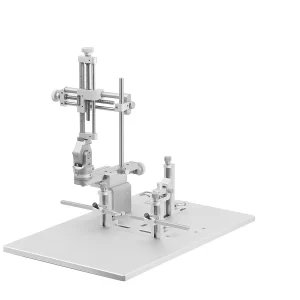The information about the structure, interactions, and dynamics of biomolecules (protein, DNA, and RNA) is essential for understanding cellular processes. This knowledge is deconvolved by scientists and used in elucidating cellular mechanisms for finding cures for human diseases. The pharmaceutical industry, for example, uses this structural information to improve on the already discovered drugs or to find new ones. There are 3 techniques that are widely used for this purpose; X-Ray crystallography [1], Nuclear magnetic resonance (NMR) [2], and cryo-electron microscopy [3].
NMR is a technique that is very useful in ascertaining the structure of those organic molecules, which can be dissolved in NMR compatible solvents to be probed in a solution form. The reason the term solution is stressed is that the structure of biomolecules can be obtained under physiological conditions by artificially adjusting temperature, pH, and concentration of salts. NMR spectroscopy is no doubt a robust approach used to ascertain the structure of compounds, however, a deep understanding of certain principles is needed in order to generate the most comprehensive spectra for the molecule. First and foremost, the NMR user has to be familiar with different aspects of the technique. The knowledge of sample preparation, chemical shifts, spin-spin coupling, and the maintenance of a homogeneous magnetic field with shim and lock are indispensable in order to generate a spectrum with sharp peaks [4].
Working with biomolecules is way trickier. 1H NMR is no doubt a good way for chemical structure determination, however, it would just show the tip of the iceberg when it comes to biomolecules. Much more advanced procedures and orchestration of different NMR methods enable the determination of the structure of biomolecules. This article will go through different aspects of Biomolecular NMR spectroscopy, using the structural determination of protein as an example.
Biomolecular NMR Spectroscopy for Proteins
The Crucial Events in History that Shaped Protein NMR Spectroscopy
The secondary structure of a protein comprises alpha helix, beta-sheets, and loops and turns. The combination of these structural elements determines the structure of proteins and every protein has a unique combination of these structural elements. These three-dimensional conformation of protein molecules are crucial for their function. It is, therefore, crucial to identify the structure of the protein molecules in order to infer their activity. Thus, the introduction of protein NMR.
The first protein NMR was done on ‘ribonuclease A’ by Martin Saunders’s lab in 1957. In 1976, Richard Ernst and his colleagues expanded on the NMR technique and invented the 2D NMR spectroscopy. Prof. Ernst received a Nobel prize for his efforts in 1991. This was followed by elucidating structures of other proteins by the Swiss scientist, Kurt Wuthrich, who was awarded the Chemistry Nobel prize in 2002 for developing NMR techniques for biomolecules.
Prof. Wuthrich was successful in predicting the structure of a protein in a solution, for the first time ever, with a high degree of accuracy. Along with fellow scientist and Nobel laureate Richard Ernst, Kurt identified the Nuclear Overhauser effect, which was used for measuring intermolecular distances in proteins. After the initial discovery of the structure of ribonuclease A, NMR has been successfully used for several other proteins. The most important, among these, are the intrinsically disordered proteins (IDPs).
NMR Proved Indispensable for the Study of Intrinsically Disordered Proteins (IDPs)
In particular, NMR has proven useful in structure determination of proteins that have intrinsically disordered regions. These proteins have no fixed secondary or tertiary structure. The design of IDPs or intrinsically disordered proteins, in a way, goes against the central dogma, which states that every protein must have a secondary structure for functionality. These proteins are implicated in cell signaling and the manifestation of diseases. Often, these proteins fail to generate crystals for X-ray crystallographic analysis and are too small to show contrast during the cryo-EM procedure [5-9].
With Great Power Comes Great Resolution
NMR machines, which are 800 MHz or greater, are used for proteins >10 kDa. This is due to greater signal resolution in the resulting spectra. Whereas, NMR machines of the range 500 and 600 MHz are used in academic institutes for smaller biomolecules.
Multiple Dimensions are Needed in Biomolecular NMR Spectroscopy
The resolving power of the NMR machine is certainly a crucial factor in structural analysis, however, it is not the only factor. 1H NMR is a very good technique for identifying the structures of chemical compounds, however, when it comes to elucidating the structures of complex biomolecules, spectra from additional NMR active nuclei need to be acquired at high resolution. These techniques are known as the 2D and 3D NMR. Carbon-13C is one of the most important among the several NMR active nuclei, which are used for structural analysis.
Carbon-13C NMR
Carbon-12C does not have magnetic spin properties since it has an even number of protons and neutrons in the nucleus. It has a spin quantum number 1 and does not contribute to the NMR spectroscopy. On the other hand, the isotope Carbon-13C is NMR active because it has an odd number of neutrons in its nucleus and has the spin quantum number ½. [10]
13C is an isotope of 12C and is present in very low abundance at around 1% in nature. This means that if we have 100 carbon atoms, 99 of them would be 12C and 1 would be 13C. So, we can appreciate that for every 10,000 atoms of carbon, only 100 would be NMR active. This means that 13C NMR is less sensitive than 1H NMR and comparatively, a larger sample volume is needed in the case of the former. The principle behind 13C NMR is similar to that discussed for 1H NMR. There are, however, some differences. If we look at the formula linking radio-frequency (n) and applied magnetic field (B0):
n= (g/2p) B0
g is the gyromagnetic ratio.
Now, interestingly, the gyromagnetic ratio of the 13C atom is a quarter of the 1H atom.
Information obtained from the 1H NMR provides an indirect way to elucidate the carbon skeleton, whereas, the 13C NMR is a more direct way to get that information.
TMS is the reference standard in both 1H and 13C NMR. The chemical shift values of 13C atoms have a range from 0-200 which is 20 times that of 1H atoms. For example, the Benzene ring has a chemical shift value of 110-175.
The 2D and 3D Spectra
2D NMR in Biomolecular NMR Spectroscopy
In a more complex molecule (such as protein), the spin-spin couplings between 1H-1H or 1H-13C atoms are difficult to interpret using just the standard 1H NMR technique. The spectrum is more complicated due to interactions between overlapping resonances. There are more couplings that need to be accounted for in the NMR spectra. The term “Coupling” is much like the term “couple” used in our day-to-day life. Just like couples eat together, and live together, and the activity of one influences the activity of the other, NMR active nuclei also a couple in a similar way with other nuclei. A protein NMR spectrum has hundreds of spectral lines overlapping with each other. Pascal’s triangle n+1 rule for spin-spin couplings [11, 12] is not followed in these cases and a complex splitting pattern is observed on the NMR spectrum. This is called the second-order coupling behavior of the interacting atoms.
In order to get an idea of the connectivity between different atoms in the molecule, the coupling behaviors need to be resolved by analyzing the spectra of different NMR active atoms for the same molecule. Next, these multiple spectra are plotted together and the interaction between two different types of spins such as between 1H and 13C atoms are compared for the peak splitting patterns. Spectra from each of the NMR active atoms are used to get a complete picture of the molecule. This process is known as 2D NMR spectroscopy[13] and forms an integral part of biomolecular NMR spectroscopy as a whole. The 1D NMR spectra also has two dimensions, for example, if we consider an NMR spectrum, it has the chemical shifts on the X-axis and signal intensity on the Y-axis. The 2D NMR is different because it has a two-frequency axis, e.g., a carbon frequency axis and the proton axis.
It is important to note that in order to have NMR active 13C atoms or 15N, these have to be incorporated into the protein of interest. The technique for isolating recombinant proteins in bacteria was established in the early 1900s. Using this method, isotopes of carbon and nitrogen could be added to the bacterial culture medium for labeling the proteins. E.coli, expression system [14, 15] is widely used for this purpose, although other expression systems such as Pichia pastoris [16] are also used when the yield of the target protein is low in the bacterial system.
Since Biomolecular NMR spectroscopy is a vast topic, the best way to get a grip is to review the individual components of the technique. For instance, there are several types of 2D NMR spectroscopy techniques. A couple of them, which are indispensable for biomolecular NMR, are described below;
Types of 2D NMR Spectroscopy Techniques
Correlation Spectroscopy (COSY):
This method reveals 1H-1H spin-spin couplings. Briefly, the technique of biomolecular NMR spectroscopy involves generating two 1H NMR spectra, which are placed perpendicular to each other on the NMR graph. Both graphs are basically the same, as they come from the same molecule. In the first instance, similar peaks on both graphs are aligned and a diagonal is drawn on the graph. All the points on the diagonal represent similar couplings on both graphs. Interestingly, there are some more points on the graph which do not fall on the diagonal line. The XY coordinates of these points are extrapolated on both graphs and the protons in the corresponding peaks are said to exhibit in a higher-order coupling behavior.
Nuclear Overhauser Effect Spectroscopy (NOESY):
This is the method in biomolecular NMR spectroscopy, used to identify the interactions between protons that do not interact with each other. In technical terms, these protons are referred to as non-equivalent. In the case of proteins, these are made up of chains of amino acids, which have a linear primary structure but soon change into a folded secondary structure.
In this process of folding, non-interacting H atoms (say A and B) could be brought close to each other. Considering the distance in terms of bonds, these hydrogen atoms might be several 100 bonds away. The hydrogens which are close to each other in space would be affected if an external pulse of radio-frequency irradiates a neighboring proton. The energy of this irradiation is transferred to the new neighbor proton if the distance between them is at least 5Å [17]. As a result, the intensity of the peak of this proton can change (either increase or decrease). This phenomenon is called dipolar coupling.
This change in the intensity is dependent on the distance between the two protons in space and as a result, this gives information regarding the 3D structure of the molecule. This is analogous to the “Newton’s cradle” experiment where 5 metallic balls are lined up next to each other (held by individual strings). When the first of the balls is released, the kinetic energy of the ball is transferred to the last ball, while the rest of the balls remain static.
1H- 15N Heteronuclear single quantum coherence spectroscopy (HSQC):
The term, heteronuclear, means “involving 2 types of NMR active nuclei”, which, in the case of biomolecules, is 1H and 15N, while for organic compounds, it is 1H and 13C [18]. This technique of biomolecular NMR spectroscopy is used for a pair of bonded atoms having different NMR active nuclei. A conventional way to denote nuclei other than 1H is to call it X nuclei. This method involves recording the resonance signal of 15N atoms and then recording the signal of 1H atoms, which was a result of spin-spin coupling from 15N atom. This would result in a 2D NMR map.
3D NMR in Biomolecular NMR Spectroscopy
The introduction of an additional dimension in the NMR spectra further resolves the complex interactions between NMR active atoms. We can understand this through an analogy to a name search on Facebook. Let’s suppose we search for the name “Catherine”. This comes up with thousands of individuals. Now, if we add “Jones” as the last name, we remove most of the crowd. Next, if we write the middle name “Zeta” we reach the page for the famous actress Catherine Zeta-Jones. Similarly, adding further dimensions to the NMR spectra allows the user to zoom in further into the interactions between NMR active nuclei.
The 3D NMR spectra are generated by merging two different 2D spectra involving 3 NMR active nuclei, for instance, 1H, 13C, and 15N. Thus, the 3D NMR spectroscopy adds a higher level of complexity for identifying biomolecules. More specifically, much like using 2D NMR spectroscopy to resolve peaks identified in 1D NMR, we need 3D NMR spectroscopy to resolve peaks that overlap in 2D NMR. The NMR specialist needs to set up a 3D NMR experiment when the chemical shift values, for example, between two amino acids (which are further apart in the protein) happen to be nearly the same. In this instance, there is a need to introduce a third dimension to further resolve the 2D spectrum.
Conclusion
NMR spectroscopy slowly and steadily evolved from applications in physics to chemistry (to identify the structure of organic compounds), and then biology (for identification of structures of biomolecules). NMR spectroscopy has contributed greatly to the fields of protein structure and drug design. Structure determination of biomolecules is quite complex, however, advancements in the NMR technique have facilitated robust data-analysis. Thus, the interaction of small molecules with complex biomolecules can also be analyzed using this technique. More so, the invention of 1.2 GHz NMR machines has paved the way for achieving greater things in biomolecular NMR spectra [19].
References
- A. Ilari, C. Savino, Protein structure determination by x-ray crystallography, Methods Mol Biol, 452 (2008) 63-87.
- K. Wuthrich, The way to NMR structures of proteins, Nat Struct Biol, 8 (2001) 923-925.
- Z.H. Zhou, Atomic resolution cryo-electron microscopy of macromolecular complexes, Adv Protein Chem Struct Biol, 82 (2011) 1-35.
- M. Balci, Basic 1H- and 13C-NMR Spectroscopy, Elsevier Science2005.
- A. Abyzov, N. Salvi, R. Schneider, D. Maurin, R.W. Ruigrok, M.R. Jensen, M. Blackledge, Identification of Dynamic Modes in an Intrinsically Disordered Protein Using Temperature-Dependent NMR Relaxation, J Am Chem Soc, 138 (2016) 6240-6251.
- S. Gil, T. Hosek, Z. Solyom, R. Kuemmerle, B. Brutscher, R. Pierattelli, I.C. Felli, NMR spectroscopic studies of intrinsically disordered proteins at near-physiological conditions, Angew Chem Int Ed Engl, 52 (2013) 11808-11812.
- M.R. Jensen, P.R. Markwick, S. Meier, C. Griesinger, M. Zweckstetter, S. Grzesiek, P. Bernado, M. Blackledge, Quantitative determination of the conformational properties of partially folded and intrinsically disordered proteins using NMR dipolar couplings, Structure, 17 (2009) 1169-1185.
- M.R. Jensen, R.W. Ruigrok, M. Blackledge, Describing intrinsically disordered proteins at atomic resolution by NMR, Curr Opin Struct Biol, 23 (2013) 426-435.
- L. Salmon, M.R. Jensen, P. Bernado, M. Blackledge, Measurement and analysis of NMR residual dipolar couplings for the study of intrinsically disordered proteins, Methods Mol Biol, 895 (2012) 115-125.
- D. Marion, An introduction to biological NMR spectroscopy, Mol Cell Proteomics, 12 (2013) 3006-3025.
- H. Fukui, The Theory of Nuclear Spin-Spin Couplings, Modern Magnetic Resonance (2008) 79-83.
- C.N.H. Jerry R. Mohrig, Paul F. Schatz, Techniques in Organic Chemistry, W. H. Freeman2006.
- K.T. Hatada K, Two-dimensional NMR Spectroscopy, NMR Spectroscopy of Polymers, (2004) 143-168.
- H. Hiroaki, Recent applications of isotopic labeling for protein NMR in drug discovery, Expert Opin Drug Discov, 8 (2013) 523-536.
- T. Sugiki, T. Fujiwara, C. Kojima, Latest approaches for efficient protein production in drug discovery, Expert Opin Drug Discov, 9 (2014) 1189-1204.
- R. Daly, M.T. Hearn, Expression of heterologous proteins in Pichia pastoris: a useful experimental tool in protein engineering and production, J Mol Recognit, 18 (2005) 119-138.
- M.I.C. Atta-ur-Rahman, Atia-tul-Wahab, Nuclear Overhauser Effect, 2 ed.2016.
- R. O.Louro, Introduction to Biomolecular NMR and Metals, Practical Approaches to Biological Inorganic Chemistry, (2013) 77-107.
- B. Corporation, Bruker Announces World’s First 1.2 GHz High-Resolution Protein NMR Data, Bruker Corporation, PRNewswire, 2019.











